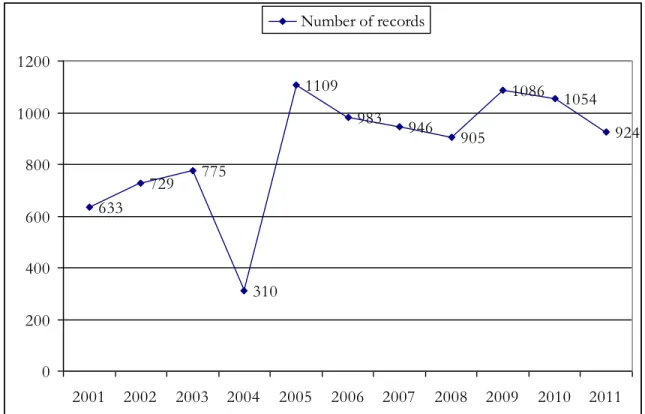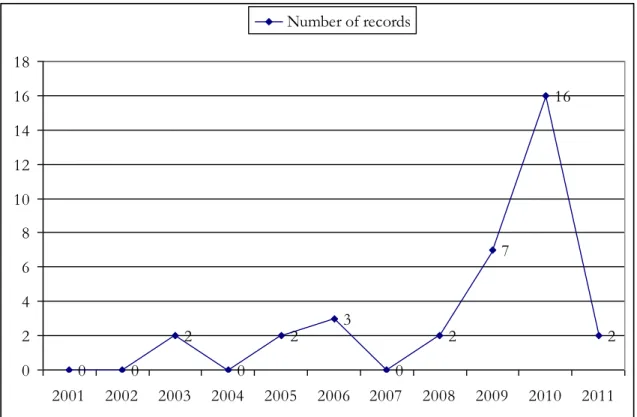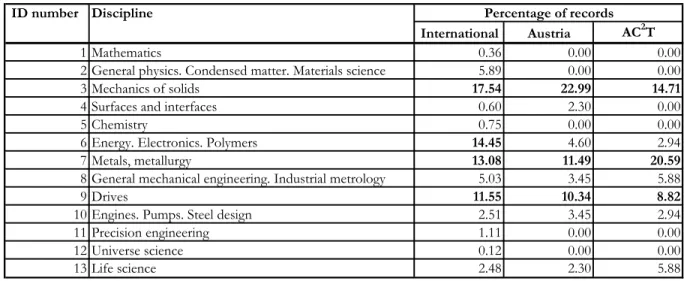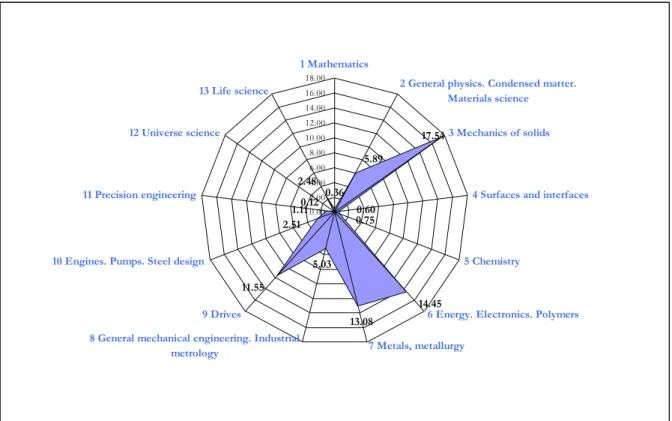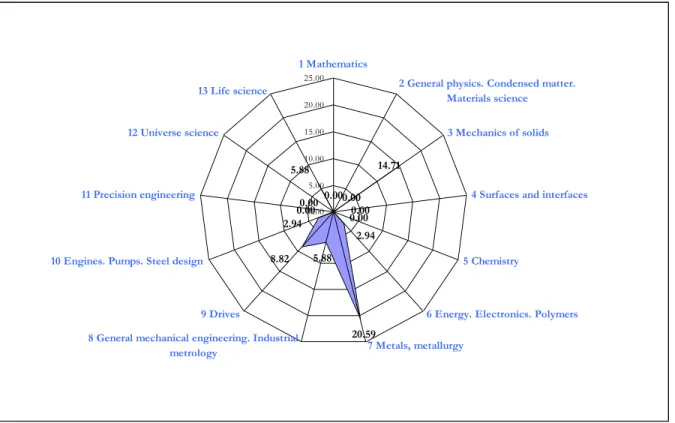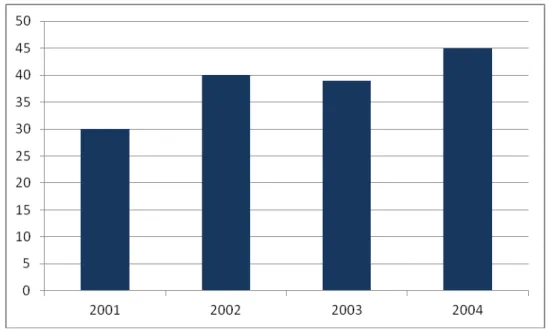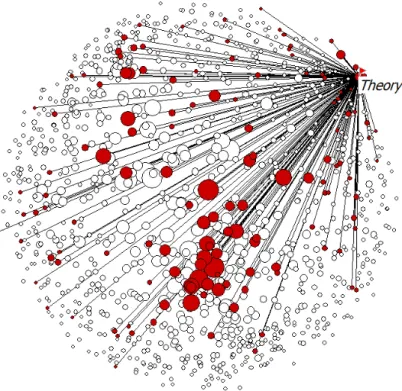HAL Id: hal-00956444
https://hal.archives-ouvertes.fr/hal-00956444
Submitted on 17 Mar 2014HAL is a multi-disciplinary open access
archive for the deposit and dissemination of sci-entific research documents, whether they are pub-lished or not. The documents may come from teaching and research institutions in France or abroad, or from public or private research centers.
L’archive ouverte pluridisciplinaire HAL, est destinée au dépôt et à la diffusion de documents scientifiques de niveau recherche, publiés ou non, émanant des établissements d’enseignement et de recherche français ou étrangers, des laboratoires publics ou privés.
Scientific Discipline : An Approach Based on
Terminological Flows
Marianne Hörlesberger, Ivana Roche, Christine Louala, Georg Vorlaufer,
Nathalie Antonot, Beatrix Wepner
To cite this version:
Marianne Hörlesberger, Ivana Roche, Christine Louala, Georg Vorlaufer, Nathalie Antonot, et al.. Searching for Theoretical Concepts in a Specific Scientific Discipline : An Approach Based on Termi-nological Flows. 21st International Conference on Management of Technology, Mar 2012, Hsinchu, Taiwan. �hal-00956444�
HOELOUROVO2012iamot Page 1 of 20
SEARCHING FOR THEORETICAL CONCEPTS IN A SPECIFIC SCIENTIFIC DISCIPLINE: AN APPROACH BASED ON TERMINOLOGICAL FLOWS
MARIANNE HÖRLESBERGER
AIT Austrian Institute of Technology GmbH, Technology Management, Donau-City-Straße 1, 1022 Vienna, Austria marianne.hoerlesberger@ait.ac.at
IVANA ROCHE
INIST-CNRS, 2 allée du Parc de Brabois, 54519 Vandoeuvre-les-Nancy Cedex, France ivana.ROCHE@inist.fr
CHRISTINE LOUALA
INIST-CNRS, 2 allée du Parc de Brabois, 54519 Vandoeuvre-les-Nancy Cedex, France christine.LOUALA@inist.fr
GEORG VORLAUFER
AC2T Research GmbH, Viktor Kaplan-Strasse 2, 2700 Wr. Neustadt, Austria vorlaufer@ac2t.at
NATHALIE ANTONOT
INIST-CNRS, 2 allée du Parc de Brabois, 54519 Vandoeuvre-les-Nancy Cedex, France
BEATRIX WEPNER
AIT Austrian Institute of Technology GmbH, Technology Management, Donau-City-Straße 1, 1022 Vienna, Austria
Abstract: Tribology is a very interdisciplinary field. Tribology, lubrication and surface technology are key technologies and with utmost importance for all branches in industrial production. Innovations in these technologies require the best possible
fundamental understanding of the complex processes taking place at the interfaces of a tribological system. Therefore the XTribology centre in AC2T Research GmbH is confronted with the challenges of a highly interdisciplinary field. In previous works, we developed an approach based on the analysis of the evolution of a specific scientific discipline by means of studying its terminology extracted from related specialized international literature. In this work we investigate the very important subfield of Tribology “the mechanism of wear”. The scientific basis is still explored. Besides general bibliometric aspects the “theories” and its connection to experiments are of specific interest.
HOELOUROVO2012iamot Page 2 of 20
Introduction
Tribology is the science and engineering of interacting surfaces in relative motion, including the study and application of the principles of friction, lubrication and wear. Tribology, lubrication and surface technology are key technologies and with utmost importance for all branches in industrial production. Innovations in these technologies require the best possible fundamental understanding of the complex processes taking place at the interfaces of a tribological system. Therefore the XTribology centre in AC2T Research GmbH is confronted with the challenges of a highly interdisciplinary field.
In previous works, we developed an approach based on the analysis of the evolution of a specific scientific discipline by means of studying its terminology extracted from related specialized international literature. After the identification of the constituent sub-fields of the discipline, our methodology operates a global characterisation of their related terminology allowing comparing their evolution and studying their relationships defined in terms of terminology exchanges. The results are presented under the shape of a web server to facilitate their assessment by scientific experts.
In this work we investigate the very important subfield of Tribology “the mechanism of wear”.
The scientific basis is still explored. There is still to be done much in the research for wear and its bridges to its applications, which entails a high potential of innovation. The work is guided by the following research questions:
Where is the focus of research in “mechanism of wear” currently on?
What are the contemporary and established theories for describing the “mechanism of wear”?
Which bridges can be identified between the experimental methods and the theories?
From the methodology point of view, the in-depth analysis of the results made available on a Tribology-devoted web server was able, in a general way, to contribute to a better understanding of the evolution of the studied core discipline and its relationships in a multidisciplinary context. In this work, we are particularly interested on the development of an analytical approach
allowing identifying the links privileged between the Tribology and the sub-fields supplying its needed theoretical background.
In the first part of this contribution a bibliometric analysis of the field “Machine components. Friction, wear, lubrication” is presented, where the search strategy, general aspects of the
publication activities, and connections to the activities in Austria and AC2T Research GmbH is discussed.
The second part deals with a detailed investigation of the content of the data set with a specific focus on theories and its connection to experiments.
HOELOUROVO2012iamot Page 3 of 20
Bibliometric analysis of the “Machine components. Friction, wear, lubrication” field
We focus on the international scientific literature published from 2001 to nowadays, dealing with
the field “Machine components. Friction, wear, lubrication” and indexed in the PASCAL
bibliographic database.
This information source provides broad multidisciplinary coverage of scientific publications and contains at the present time about 20 million of bibliographic records from the analysis of the scientific and technical international literature published predominantly in journals and conference proceedings.
The corpus is obtained from the following query:
(tribolog* ou nanotribolog* ou microtribolog* ou tribofilm* ou tribocorrosi* ou triboelectricit* ou mechanoluminescen* ou triboluminescen* ou triboch?mi* ou tribomet* ou tribosens* ou nanolubrification ou cc=001d11g06 ou cc=001d12d02 ou cc=001b80a40p ou (mc="usure" et (wear* ou friction ou orthop* ou biomec*)) ou mc=lubrification ou (mc="contact mecanique" et mc=frottement) ou sn="1545-858x" ou sn="0301-679x" ou sn="0036-8792" ou sn="0724-3472" ou sn="1045-7828" ou sn="0742-4787" ou sn="0024-7154" ou sn="0043-1648" ou sn="1040-2004") et (dp=2001 ou dp=2002 ou dp=2003 ou dp=2004 ou dp=2005 ou dp=2006 ou dp=2007 ou dp=2008 ou dp=2009 ou dp=2010 ou dp=2011)et(cc=001d12d*)
The obtained result is a corpus of 9,454 records representing the worldwide production of the
field “Machine components. Friction, wear, lubrication” in the PASCAL database for the
considered period.
This corpus is analysed by means of bibliometric analysis tools in order to highlight some characteristics of the worldwide production: annual productivity, journals, authors, affiliation. In parallel, we examine the position of the Austrian production in the international scientific landscape and, more finely, we focus on the AC2T literature characteristics in the Austrian context. In this study, the Austrian production is determined from the worldwide corpus by searching for the bibliographic references containing at least one author whose country of affiliation is Austria. Also, the AC2T production is identified by a second filtering retaining exclusively the bibliographic references having at least one occurrence of this institute in their list of affiliation addresses.
Annual productivity
In the considered period (2001-2011), the international production is represented by 9,454 records, the Austrian one by 87 records and the AC2T one by 34 records. The Austrian
production represents 1% of the worldwide one. The AC2T production corresponds to 0.4% of the international one and 39% of the national production.
In the figures 1, 2 and 3, we present the annual distribution of, respectively, the worldwide, the Austrian, and the AC2T productions.
HOELOUROVO2012iamot Page 4 of 20 633 729 775 310 1109 983 946 905 1086 1054 924 0 200 400 600 800 1000 1200 2001 2002 2003 2004 2005 2006 2007 2008 2009 2010 2011 Number of records
Figure 1. Distribution by year (2001-2011) of the international production in the field “Machine components. Friction,
wear, lubrication” 2 1 5 1 7 5 5 12 16 22 11 0 5 10 15 20 25 2001 2002 2003 2004 2005 2006 2007 2008 2009 2010 2011 Number of records
Figure 2. Distribution by year (2001-2011) of the Austrian production in the field “Machine components. Friction, wear,
HOELOUROVO2012iamot Page 5 of 20 0 0 2 0 2 3 0 2 7 16 2 0 2 4 6 8 10 12 14 16 18 2001 2002 2003 2004 2005 2006 2007 2008 2009 2010 2011 Number of records
Figure 3. Distribution by year (2001-2011) of the AC2T production in the field “Machine components. Friction, wear,
lubrication”
A first observation of the Figures 1, 2 and 3 shows a significant decrease of the production in 2004. This artefact is due to a modification of the PASCAL database coverage and not to a real drop off of the field production. On the other hand, let us remark that the annual production of the 2011 year is not yet complete and, by consequence, it looks anormally weak in Figures 1, 2 and 3.
This is the reason we do not take into account the values of these years in the following analysis
of the annual productivity of the field “Machine components. Friction, wear, lubrication”.
While international literature presents a quite regular production since 2005, we can observe a clear progress of the Austrian production since 2007. The same observation can be made for the AC2T which shows a spectacular progression since 2008. Particularly, we can also notice that in 2010 the AC2T production represents more than the half of the Austrian one.
Publishing types
Classically, the diffusion of research results is made either by their publication in journals or by
their presentation to peers in conferences. In the field “Machine components. Friction, wear, lubrication” the part of communications presented in conferences is quite high: 27%, 43% and 53
%, respectively, for international, Austrian and AC2T productions. This would lead us to affirm that this scientific community considers very important to exchange on their outcomes in the
HOELOUROVO2012iamot Page 6 of 20 direct interactive context that conferences bring. The particularly high rate of AC2T could be the sign of the important attachment of this institute to this type of exchanges.
Interdisciplinarity of the field
The data set is extracted from the PASCAL database that is specifically adapted to point out the interdisciplinarity of a field. Indeed, its records benefit from an indexing by both keywords and multiple thematic categories of a disciplinary classification scheme assigned to each individual publication, either manually by scientific experts or automatically, based on a content analysis. This category multiplicity allows us to identify the interactions between different disciplines by considering that, if a reference gets different thematic categories, this means that the content of the related document deals with different disciplines.
In the figures 4, 5 and 6, we present respectively the repartition of the international, the Austrian, and the AC2T productions in the field “Machine components. Friction, wear, lubrication” by considering their bibliographic references dealing also with other disciplines. They are, in order to facilitate the reading, organized in 13 different disciplinary sets that we detail in table 1.
Table 1. List of the 13 disciplines in relation with “Machine components. Friction, wear, lubrication”
ID number Discipline
International Austria AC2T
1 Mathematics 0.36 0.00 0.00
2 General physics. Condensed matter. Materials science 5.89 0.00 0.00
3 Mechanics of solids 17.54 22.99 14.71
4 Surfaces and interfaces 0.60 2.30 0.00
5 Chemistry 0.75 0.00 0.00
6 Energy. Electronics. Polymers 14.45 4.60 2.94
7 Metals, metallurgy 13.08 11.49 20.59
8 General mechanical engineering. Industrial metrology 5.03 3.45 5.88
9 Drives 11.55 10.34 8.82
10 Engines. Pumps. Steel design 2.51 3.45 2.94
11 Precision engineering 1.11 0.00 0.00
12 Universe science 0.12 0.00 0.00
13 Life science 2.48 2.30 5.88
HOELOUROVO2012iamot Page 7 of 20 0.36 5.89 0.60 0.75 14.45 13.08 5.03 11.55 2.51 1.110.12 2.48 17.54 0.00 2.00 4.00 6.00 8.00 10.00 12.00 14.00 16.00 18.00 1 Mathematics
2 General physics. Condensed matter. Materials science
3 Mechanics of solids
4 Surfaces and interfaces
5 Chemistry
6 Energy. Electronics. Polymers 7 Metals, metallurgy
8 General mechanical engineering. Industrial metrology
9 Drives 10 Engines. Pumps. Steel design
11 Precision engineering 12 Universe science
13 Life science
Figure 4. Repartition of the international production in the 13 disciplines in relation with the field “Machine components.
Friction, wear, lubrication”
0.000.00 2.30 0.00 4.60 11.49 3.45 10.34 3.45 0.000.00 2.30 22.99 0.00 5.00 10.00 15.00 20.00 25.00 1 Mathematics
2 General physics. Condensed matter. Materials science
3 Mechanics of solids
4 Surfaces and interfaces
5 Chemistry
6 Energy. Electronics. Polymers 7 Metals, metallurgy
8 General mechanical engineering. Industrial metrology
9 Drives 10 Engines. Pumps. Steel design
11 Precision engineering 12 Universe science
13 Life science
Figure 5. Repartition of the Austrian production in the 13 disciplines in relation with the field “Machine components. Friction, wear, lubrication”
HOELOUROVO2012iamot Page 8 of 20 0.000.00 0.00 0.00 2.94 20.59 5.88 8.82 2.94 0.000.00 5.88 14.71 0.00 5.00 10.00 15.00 20.00 25.00 1 Mathematics
2 General physics. Condensed matter. Materials science
3 Mechanics of solids
4 Surfaces and interfaces
5 Chemistry
6 Energy. Electronics. Polymers 7 Metals, metallurgy
8 General mechanical engineering. Industrial metrology
9 Drives 10 Engines. Pumps. Steel design
11 Precision engineering 12 Universe science
13 Life science
Figure 6. Repartition of the AC2T production in the 13 disciplines in relation with the field “Machine components.
Friction, wear, lubrication”
We can observe that the international literature in the field “Machine components. Friction, wear, lubrication” deals especially with “Mechanics of solids”, as well as with Engineering sciences like “Energy, Electronics and Polymers”, and finally with “Metals, metallurgy” and “Drives”. Austrian production focuses for a great part on “Mechanics of solids”, and then on “Metals, metallurgy” and “Drives”, showing that studies are conducted in the field of fundamental
sciences as well as in more applied sciences. The AC2T publications concentrate mainly on
“Metals, metallurgy”, and to a lesser extent on “Mechanics of solids” and on “Drives”, pointing
out a more applied research oriented toward Engineering sciences. Affiliations
Bibliometric analyses launched on countries of affiliation appearing in publications of both Austria and the AC2T in the field “Machine components. Friction, wear, lubrication” show important scientific collaborations with Germany and with India. On the national level, 18.4 % of publications are written together with German scientists while 6.9 % of the analysed records concern collaborations with India. For the AC2T, the trend is inverted in the sense that its largest number of collaborations occurs with Indian laboratories in 17.6 % of records. Germany follows with 11.8 % or publications.
Furthermore, a detailed analysis of the Austrian affiliations in the obtained corpus, confirms the
very important position of the Austrian Center of Competence for Tribology in the “Machine components. Friction, wear, lubrication” field. Another important actor is the Department of
HOELOUROVO2012iamot Page 9 of 20 seems to be a significant area of tribology application fields in Austria. This confirms the precedent observation made in the interdisciplinarity study.
Journals
In the tables 2, 3 and 4, we present the top journals of, respectively, the worldwide, the Austrian, and the AC2T productions.
Table 2. The six top journals of the worldwide production in the field “Machine components. Friction, wear, lubrication”
Title Percentage of records
Wear 36.67
Tribology international 15.98
Journal of tribology 10.17
Tribology transactions 7.20
Tribologie und Schmierungstechnik 5.13
Tribology & lubrication technology 4.20
Table 3. The six top journals of the Austrian production in the field “Machine components. Friction, wear, lubrication”
Title Percentage of records
Wear 32.18
Tribologie und Schmierungstechnik 31.03
Tribology international 24.14
Vehicle System Dynamics 3.45
Journal of tribology 2.30
Thin solid films 2.30
Table 4. The four journals of the AC2T production in the field “Machine components. Friction, wear, lubrication”
Title Percentage of records
Tribology international 47.06
Tribologie und Schmierungstechnik 38.24
Wear 11.77
Tribology transactions 2.94
The first thing which we can bring to light when analysing the three tables is the important position of the journal in German language, Tribologie und Schmierungstechnik, in both the Austrian and the AC2T corpus. Indeed, in these two cases, it ranks second while it is in fifth place in the international literature.
The other observation we can make about the national production is that Austrian researchers,
although being interested in the fundamental aspects of the field “Machine components. Friction, wear, lubrication”, also focuses on particular applications, as evidenced by the presence of the periodicals “Vehicle System Dynamics” and “Thin Solid films”.
HOELOUROVO2012iamot Page 10 of 20 Paper language
In the tables 5, 6 and 7, we present the most frequent languages used in scientific publications in the field “Machine components. Friction, wear, lubrication” of, respectively, the worldwide, the Austrian, and the AC2T productions.
Table 5. The most frequent paper languages of the worldwide production in the field “Machine components. Friction, wear, lubrication”
Language Number of records Percent
English 8887 94,003
German 456 4,823
French 101 1,068
Spanisch 8 0,085
Japanese 3 0,032
Table 6. The most frequent paper languages of the Austrian production in the field “Machine components. Friction,
wear, lubrication”
Language Number of records Percent
English 69 79,31
German 18 20,69
Table 7. The most frequent paper languages of the AC2T production in the field “Machine components. Friction, wear,
lubrication”
Language Number of records Percent
English 26 76,471
German 8 23,529
At a first glance, the more the geographic zone is limited, the more the percent of German language in tribology scientific publications becomes important.
For comparison, if we consider the global scientific literature in the same period, we notice that English represents 93% of the paper languages, followed by French with 6%. German comes third with 0.7%.
This analysis confirms the trend observed in the journal ranking.
Can we therefore deduce that the tribology scientific field is an important research area in German speaker countries?
The results obtained in this work by means of bibliometric tools in the field “Machine
components. Friction, wear, lubrication” show an increase of the Austrian research activity in
this domain.
The interest of Austria for applied fields of tribology, in particular for metallurgy, is highlighted
by the analysis of the interdisciplinarity of the field “Machine components. Friction, wear, lubrication” as well as the journal distributions.
HOELOUROVO2012iamot Page 11 of 20 Moreover, we evidenced the growing proportion of the AC2T annual production in the Austrian landscape in the last years. This point was confirmed by the study of the Austrian affiliations and trends to suggest that the Austrian Center of Competence for Tribology is at the forefront of
Austrian research in the field “Machine components. Friction, wear, lubrication”. The content in connection to the term “theory”
For a more detailed analysis we consider all terms1 in the frequency interval of [20; 999]. The frequency of a term is given by its occurrence in an article. It is counted once if it occurs at least once in an article. The interval [20; 999].was chosen because of the following considerations.
Terms with a higher frequency are much more general such as “tribology” with a frequency of 8,006, or “experimental study” of a frequency of 4,276, or “wear” with a frequency of 1,527 for
example. Terms with a low frequency deal possibly with new ideas or aspects far away from an established research topic, or are spelling mistakes.
The most visible terms of the considered field “Machine components. Friction, wear, lubrication” are presented in the following Table 8 (12 terms with the highest frequency in the
considered interval):
Table 8. Most visible terms in the considered field.
Keyword Frequency
Rough surface 992
Lubrication 947
Scanning electron microscopy 923
Lubricating oil 914 Roughness 908 Dry friction 889 Metal 823 Abrasive wear 813 Wear rate 792 Sliding friction 727 Sliding wear 704 Contact stress 700
Which terms occur the first time in 2011? These terms indicate the current research topics or emerging topics.
Table 9. Terms with a frequency higher than 1 and the first time in 2011.
Documentation Extract Lead sulfide Railway industry Recovery Springback 1
Term or keyword or descriptor denote main aspects of an article, and describe the matter of the article very generally.
HOELOUROVO2012iamot Page 12 of 20 The following titles (all from 2011 as in Table 9 shown) deal with the terms in table 9:
Documentation
o Documentation of tool wear progress in the machining of nodular ductile iron with
silicon nitride-based ceramic tools
o Experimental surface contact fatigue failure analysis of a hypoid pinion used in
differential system of a truck
Extract
o Harmonic Wavelet Packet Analysis of Friction-Induced Vibration
o A review: plant extracts and oils as corrosion inhibitors in aggressive media Lead sulfide
o Friction and wear behaviour of bacterial cellulose against articular cartilage
o Tribocorrosion behavior of CoCrMo alloy for hip prosthesis as a function of loads: A
comparison between two testing systems
Railway industry
o Influence of track conditions and wheel wear state on the loads imposed on the
infrastructure by railway vehicles
o A study of rolling contact fatigue crack growth in U75V and U71 Mn rails
Recovery
o Surface Defect Generation and Recovery in Cold Rolling of Stainless Steel Strips
o Gap control for near-dry EDM milling with lead angle
Springback
o Elastoplastic Stress Analysis and Residual Stresses in Cylindrical Bar Under Combined
Bending and Torsion
o Evaluation of lubricants for electrically-assisted forming The term “theory”
Now we investigate especially the term “theory” and its co-terms.
The term “theory” occurs in 588 articles (either in the title, in the abstract, or as a
descriptor/keyword), which means in 6.22% of the data set. If we consider only the descriptor field, we get 154 articles with “theory” as a descriptor/keyword, which is approximately 1.63%
of the considered data set. Hence we can say that “theory” seems to play a subordinate role in
this technology field.
Remarkable is the fact that the term “theory” occurs only till 2004 in this data set (see figure 7), whereas “theoretical study” also can be found in 2011.
HOELOUROVO2012iamot Page 13 of 20
Figure 7. Number of articles with the keyword “theory” over all considered years.
Looking for specific theories in this data set (with “theory” in the descriptor field) we get the following theories and titles:
A simple elastic model is used to describe the elastic deformation of the bearing liner in the
article The effects of surface irregularities on the performance characteristics of flexible finite journal bearings lubricated with couple stress fluids (2002)
Approximation theory in
o Soot Characterisation and Diesel Engine Wear (2004)
o Steady motion of a drop along a liquid interface (2003)
o Efficient parallel numerical solver for the elastohydrodynamic Reynolds-Hertz
problem (2001)
Constraint theory in
o Optimization of set-up conditions for stability of the centerless grinding process
(2004)
o Multidirectional compliance and constraint for improved robotic deburring. Part 1:
Improved positioning (2001
Control Theory in Design and implementation of command and friction feedforward control
for CNC motion controllers (2004)
o Designing automotive gear oils for the new millennium (2002)
Drainage theory in A review of drainage and spontaneous rupture in free standing thin films
with tangentially immobile interfaces (2003)
Fuzzy theory in Fuzzy synthetic method for life assessment of power transformer (2004) Graph theory in Analysis of tool and workpiece interaction in diamond turning using
graphical analysis of acoustic emission (2003)
In the article The thickness of a marangoni-driven thin liquid film emerging from a meniscus
HOELOUROVO2012iamot Page 14 of 20
Kabalnov-Wennerstrom theory (from 1996) in the article Lubrication in aqueous solutions
using cationic surfactants - A study of static and dynamic forces (2002)
Lubrication theory in
o Friction reduction in low-load hydrodynamic lubrication with a hydrophobic surface
(2007)
o Lubrication in aqueous solutions using cationic surfactants - A study of static and
dynamic forces (2002)
o Tribology properties of TiCp/ZA43 composite under continuously lubricated sliding
condition (2002)
o The effects of surface irregularities on the performance characteristics of flexible
finite journal bearings lubricated with couple stress fluids (2003)
o Multidirectional compliance and constraint for improved robotic deburring. Part 2:
Improved bracing (2001)
o Particle convection in an evaporating colloidal droplet (2002)
o Particulate flow simulations using lubrication theory solution enrichment (2002) o Lateral drying in thick films of waterborne colloidal particles (2011)
o Thermal effects in cylindrical journal bearings of high-speed gearboxes (2003)
The articles with the following titles deal with “theoretical study” (three articles are published in 2011, Four are published before 2008):
Hydrodynamic interactions for the measurement of thin film elastic properties, 2011 Terraced spreading of nanofilms under a nonmonotonic disjoining pressure, 2011
Direct verification of the lubrication force on a sphere travelling through a viscous film
upon approach to a solid wall, 2011
MODELING OF AN ELASTOMERIC FRICTION DAMPER, 2009 An application of contact melting theory to skates sliding on ice, 2008
The term “theory” concurs with 138 different terms (out of 1,149 descriptors in the considered
data set.
For a detailed analysis the software BibTechMon (Bibliometric Technology Monitoring developed in the department Technology Management of the AIT Austrian Institute of Technology) is applied. This software is based on co-object analysis. In case we consider for instance the keywords because of their common occurrence in articles a node stands for a keyword. Two nodes (keywords) share an edge if they occur in the same article. The strength of
an edge is given by a similarity coefficient like the Jaccard coefficient. The “size” of a node is
given by the frequency of a keyword, which means the number of articles a considered keyword occurs at least once. This software helps especially in the analysis of the data. Furthermore it presents the network graphs of e.g. keywords.
Figure shows the term “theory” and its co-terms (the coloured ones). The term “theory” is more on the edge of the network in the north east part. This means that this term does not play a
HOELOUROVO2012iamot Page 15 of 20 central role in the considered data set. Terms in the centre of the network have often a connection to many other terms and therefore articles. Terms more in the centre occurs in many articles of the considered data set and deal with the main aspects of the investigated data. In our case the
term “theory” is on the edge, but it is obvious that “theory” is connected to terms in the centre, as
figure 7 shows.
Table 10. Co-terms to « theory » with the highest co-frequency.
co-term co-occurence Experiments 72 Lubrication 49 Lubricants 41 Wear of materials 19 Viscosity 18 Additives 17 Insulating oil 17 Lubricating oils 16 Oxidation 12 Abrasives 11
The term with the highest co-frequency to “theory” is “experiments”, as Table shows. This fact
is remarkable, because experts working in this field and familiar with “experiments” think that
there are not so many theories which could support the experimental results. We will investigate this problem in more details.
HOELOUROVO2012iamot Page 16 of 20 Experiment – Theory
In the network graph the terms “experiment” and “theory” connected 228 times, what means that
the two terms occurs together in 228 articles out of 9,454, only in 2.41%, a very low percentage. Furthermore the articles are old; the youngest ones are published in 2004.
Figure 9. The term “theory” and “experiments” in the network graph at the edge at north east.
Few examples of titles published in 2004 (there are 32 articles in 2004, and these are the youngest ones) which connect experiments and theory are the following once:
Mechanism of Boundary Film Formation from n-Hexadecane
Coated gearings and bearings optimised for environmentally acceptable lubricants High-pressure rheology of eight synthetic lubricants based on phase diagrams The tribological properties of several silahydrocarbons for use in space mechanisms The term “theory” in titles and abstracts
If we search for the term “theory” in titles or abstracts we 389 articles or 4.11% of the
publications. That means that it is not necessary also in the field “descriptor”. 30 articles with
these conditions are published in 2011. They deal with the following kinds of theories:
cyclic plasticity theory; density functional theory; dynamics theory of the vehicle; Erigen s micropolar theory; Euler s belt theory;
HOELOUROVO2012iamot Page 17 of 20
extreme-value theory;
FASTSIM (simplified theory of rolling contact); fractal theory;
Group theory;
Hertz Contact Theory; Hertz theory;
Hopf bifurcation theory;
Irreversible thermodynamic theory;
isomorphic replacement theory in mineralogy and petrology; Jakobsson-Floberg-Olsson cavitation theory;
Johnson-Kendall-Roberts (JKR) theory; Kalker s non-Hertzian rolling contact theory; linear wear theory;
lubrication theory; M-estimation theory; rolling contact theory; rubber friction theory;
stokes microcontinuum theory; theory of scale;
three-dimensional theory of elasticity in conjunction with Archard’s generalized wear
equation;
These theories are either applied, or the described methodologies are based on these theories.
There are six articles with the term “theory” in the titles in 2011:
Development of a Centrifugal Oil Lubricator for Long-Term Lubrication of Spacecraft
Attitude Control Systems-Design and Theory (University of South Australia Mawsonlakes Campus)
RCF and wear in theory and practice-The influence of rail grade on wear and RCF
(Voestalpine Schienen GmbH, Austria; Austrian Academy of Sciences, Austria; University of Leoben, Austria; RailMeasurement Ltd, Germany; National Research Council Ottawa, Canada; University Clayton, Australie)
A Review of Elasto-Hydrodynamic Lubrication Theory (SKF Engineering & Research Centre
Nieuwegein; Universite de Lyon, France)
Thermal Fly-Height Control Slider Instability and Dynamics at Touchdown: Explanations
Using Nonlinear Systems Theory (University of California,Berkeley, CA, USA)
Characteristics of micro-gas journal bearings based on kinetic theory (National Cheng Kung
University, Taiwan; National Kaohsiung University of Applied Sciences, Taiwan)
A Greenwood & Williamson theory for line contact (University Cambridge, UK; Politecnico
di Bari, Italy
Experts in this field will observe that these articles and also the mentioned theories above connect experiments and theories. Nevertheless the question is if there is a specific theory / model for describing a rounded technological problem.
HOELOUROVO2012iamot Page 18 of 20 Compared with the whole corpus of the data (9,454 records all in all) we see that “theory” is not covered well, is not discussed or developed in this field of investigation. Either there are fewer theories in this field or they are covered with another terminology. Therefore we touch briefly a further term.
The term “modelling”
“Modelling” occurs in 51 articles. Figure 10 shows that this term occurs each year of the time
span in our data set. The frequency alternates firstly and increases slightly finally. The following titles are examples of the latest research (2011):
The Effect of Nonuniform Viscosity on Stagnation Point Pressure
Electrothermomechanical Finite-Element Modeling of Metal Microcontacts in MEMS Analytical modelling of the three-dimensional steady-state temperature in a bearing ring Entry, start up and stability effects in visco-plastically lubricated pipe flows
Investigation of the temperature field induced in the process of friction of a composite
pad and a homogeneous disc
Figure 10. The term “modelling” in the data set over the considered time span.
But as well as “modelling” and “empirical model” are on the edge of the network graph. Hence
HOELOUROVO2012iamot Page 19 of 20
Figure 11. The term “modelling” and “empirical model” in the data set over the considered time span.
Conclusions
We learn from this study that there is a slight decrease in the productivity worldwide, whereas Austria and especially AC2T show an increase in the publication activities in the field of
“Machine components. Friction, wear, lubrication“.
The international literature in the field “Machine components. Friction, wear, lubrication” deals
especially with “Mechanics of solids”, as well as with Engineering sciences like “Energy,
Electronics and Polymers”, and finally with “Metals, metallurgy” and “Drives”.
Austrian production focuses for a great part on “Mechanics of solids”, and then on “Metals, metallurgy” and “Drives”, showing that studies are conducted in the field of fundamental
sciences as well as in more applied sciences. The AC2T publications concentrate mainly on
“Metals, metallurgy”, and to a lesser extent on “Mechanics of solids” and on “Drives”, pointing
out a more applied research oriented toward Engineering sciences.
Which role does “theory” play in this field? The analysis concerning “theory” is poor. The term
“theory” occurs in 588 articles (either in the title, in the abstract, or as a descriptor/keyword),
which means in 6.22% of the data set. If we consider only the descriptor field, we get 154
articles with “theory” as a descriptor/keyword, which is approximately 1.63% of the considered data set. Hence we can say that “theory” seems to play a subordinate role in this technology
HOELOUROVO2012iamot Page 20 of 20 field. The experts in Tribology will give their comments till the conference is running so that the benefit of such an analysis can be assessed.
Bibliometric methods give a good overview to a specific field generally. But if you would like to know specific details it is necessary to read the article, what is evident. However bibliometric methods help to go into details easily.
References
Polanco X., François C., Royauté J., Besagni D., Roche I. (2001). Stanalyst®: An integrated environment for clustering and mapping analysis on science and techn ology. In: Proceedings of the
8th ISSI, Sydney, July 16th -20th
Roche I., Besagni D., François C., Hörlesberger M., Schiebel E. (2010). Identification and characterisation of technological topics in the field of Molecular Biology, Scientometrics, 82, 3, pp. 663-676
Roche I., François C., Besagni D. (2007). Les méthodes bibliométriques en soutien d’une approche
expert dans la détection de technologies prometteuses, VSST’2007 – Veille Stratégique
Scientifique & Technologique, Marrakech, 21-25 octobre 2007
Roche I., Hörlesberger M., Vorlaufer G., Wepner B., Besagni D., François C., Schiebel E (2011). Upcoming concepts in a specific scientific discipline: an analysis based on a categorisation of the related terminology; ENID (European Network of Indicator Designers) Conference 2011, 7 – 9 September, Rome.
Schiebel E., Hörlesberger M., Roche I., François C., Besagni D. (2010). An advanced diffusion model to identify emergent research issues: the case of optoelectronic devices, Scientometrics, 83, 3, pp. 765-781
